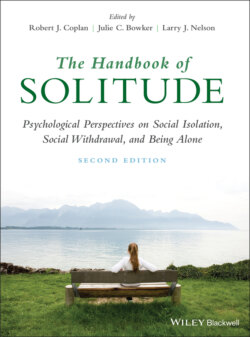Читать книгу The Handbook of Solitude - Группа авторов - Страница 16
Culture.
ОглавлениеThe more that we learn about the complex nature of solitude, the more we also come to realize that the meaning and impact of spending time alone must be considered within a broader cultural context. There is considerable variation across cultures in attitudes and beliefs regarding aspects of solitude (Buttrick et al., 2019). It is tempting to apply the notion of goodness of fit (Thomas & Chess, 1977) as a simple way to explain differences in the meaning and implications of solitude across societies and cultures. That is, if solitude is generally valued or even encouraged within a given culture, then the choice to spend time alone might be relatively adaptative, and thus, associated with more positive outcomes because it matches or is consistent with cultural values and norms. However, and perhaps not surprisingly given the complex and multidimensional nature of solitude, it appears that the impacts of culture on the causes and consequences of solitude are extremely complex and nuanced.
For example, there is some evidence to suggest that extraversion is more strongly predictive of well‐being in Western cultures (particularly North America) than in non‐Western cultures, because of the high value placed on being outgoing and sociable in these societies (Kim et al., 2016). Similarly, shyness more strongly predicts indices of negative life quality in Western as compared to East Asian cultures (Rapee et al., 2011). As well, because of the value placed on sociability in the West, children who play alone in the presence of peers (e.g., at preschool or in the schoolyard) tend to evoke negative responses from their classmates (Coplan et al., 2013; Hart et al., 2000).
Yet, Western cultures are thought to also value independence and self‐reliance (Marjoribanks, 1994). In this regard, the personal choice to spend time alone appears to be acknowledged as a normative belief in such societies (Bowker et al., 2020), and in and of itself, a non‐fearful preference for solitude is relatively accepted by others (Nelson, 2013). However, in other cultures (e.g., China) that value devotion to interdependence and the collective (e.g., peer group) over the individual, the decision to remove oneself from the collective (for any reason) may be viewed as selfish and deviant (Chen, 2019), and responded to quite negatively (Liu et al., 2015; Liu et al., 2017; Nelson et al., 2012). But, it has also been argued that East Asian cultures place greater value and are more likely to encourage humble and socially unassertive behaviors, because they maintain group harmony and promote collectivistic values (Schreier et al., 2010; Xu et al., 2007). Finally, it should be noted that not all Western cultures view sociability in the same way. For example, Finish culture places a high value on quietness and the ability to be “comfortable in silence” (Berry et al., 2004, p. 270).
These are just a few examples of the complexities involved in considering aspects of solitude across cultures. It is only in understanding the cultural context for why a solitary behavior may be seen as adaptive or problematic that we begin to see the situation clearly and accurately. Thus, we need to be cautious about broadly categorizing certain forms of solitude as either “good” or “bad” when, instead, it is really only by understanding the cultural context within which the solitary behavior is enacted that we that we can begin to understand why the behavior may be perceived positively or negatively, and more importantly, how it may lead to positive or negative outcomes in the lives of individuals.
